 it
it  en
en
Archive 2015
We have seen the disappearance from the Indonesian Authority's website of the final report regarding the accident above. Therefore, the link we posted online last year became unusable. The report can now be downloaded here.
The most relevant event of this quarter was undoubtedly that occurred in India on December 4, when the crew of a Dash 8, just after a night landing, saw a herd of about forty wild boars walking on the runway, almost certainly entered in the airport through a hole in the fence. Sometimes one spends time and energies to study new devices and strategies to reduce the risk of collisions with wildlife and underestimates the simplest prevention measures, such as a systematic control of the airport fences.
Talking of new devices, we would like to point out that offered by the Italian Tecnoag, which has branded its product FalkoonTM.
It is basically a small balloon inflated with helium with the shape of a bird of prey and controlled by a plastic cable, but don’t let its apparent simplicity deceive you; in fact it collects and combines the experiences achieved over the years with the more complex radio-controlled model aircraft called “Falco Robot”” many times described on this website. Of course, being a static tool, it can’t match its excellent performances, but it represents a well-balanced cost/effectiveness device and, if used intelligently, can be a valuable tactical tool in different situations and in different environments, including airports.
- 1 October – Memphis (TN)
Federal Express MD11, on final struck a bird that caused minor damage to the nose gear and a hydraulic line; - 5 October – Rome
Alitalia A330, possible impact with a gull after takeoff that caused the return of the aircraft and its replacement; - 8 October – Seattle (WA)
Delta A330, after take-off the crew was informed by another aircraft that the right engine ingested a bird; in the absence of abnormal parameters the crew decided to continue the transpacific flight but after they knew that the runways has been closed due to the presence of debris, they decided to return advising that both engines were running normally; flight delayed to the next day; - 9 October – Tel Aviv, Alitalia A321
rejected take-off at low speed after the left engine ingested two birds; flight cancelled; - 9 October – Cairns, Jetstar A320
bird strike during the initial climb that prompted the crew to return for landing; flight cancelled; - 14 October – Delhi
British Airways B777, on approach flew through a flock of birds suffering multiple impacts and damage to the radome; return flight delayed for 30 hours; - 16 October – Cincinnati (KY)
Kalitta B747, on approach hit a bird that caused damage to the landing light; - 20 October – Weeze
Ryanair B737, bird strike at take off with a buzzard, later found on the runway; the crew continued the climb and were enroute at FL370 when decided to return to Weeze as result of the bird strike about 65’ later; - 21 October – Paris CDG
Tahiti Nui A340, during the initial climb struck a bird; the crew stopped the climb at FL 070, levelled off, dumped fuel and returned to CDG about 100’ later; flight cancelled; - 22 October – Cagliari
Volotea B717, during the approach struck a bird; the damage to the aircraft was discovered after the passengers boarded for the next flight; flight delayed to the next day; - 26 October – Berlin (Tegel)
Germanwings A320, bird strike during the initial climb; returned 15’ later; - 26 October – Bari
Alitalia A320, struck a bird during the approach; damage to a flap; - 27 October – Austin (TX)
Southwest B737, the right engine ingested a bird during the initial climb; in the absence of abnormal parameters the crew continued the flight for three hours to destination, where an inspection revealed the engine suffered a damage; - 27 October – San Jose (CA)
rejected take off at high speed due to a bird ingestion into the right engine; - 29 October – Rostov
Aeroflot A320, rejected take off at high speed further to a bird ingestion into one engine; - 30 October – Delhi
Cathay Pacific B747, bird strike during the initial climb; the crew dumped fuel and returned about 60’ later; - 30 October – Raleigh/Durham (NC)
Southwest B737, during the initial climb at 500 ft. struck a bird that hit the left engine; immediate return 10’ later; - 6 November – Kansas City (MO)
Southwest B737, impact with bird during the final approach; unknown damage to the trailing edge flaps; - 8 November – West Palm Beach (FL)
Southwest B737, during the take-off run suffered a bird strike that initially was identified in the nose gear; after the landing, occurred about 10’ later, an inspection revealed a bird ingestion in the left engine and substantial damage; the occurrence has been rated an accident; - 8 November – Salt Lake City (UT)
Delta A320, bird strike during the final approach; unknown damage; - 9 November – Las Vegas (NV)
American Airlines B737, during the initial climb hit a big bird; immediate return after 10’ in emergency and minor damage but flight cancelled; - 9 November – San Francisco (CA)
United Airlines B737, just before the landing struck a bird that hit an engine; minor damage; - 14 November – Orlando (FL)
American Airlines B737, on final approach about 5nm before touch down the left engine impacted with a bird, some parts of which were ingested in the engine itself; damage also to the nose cone;
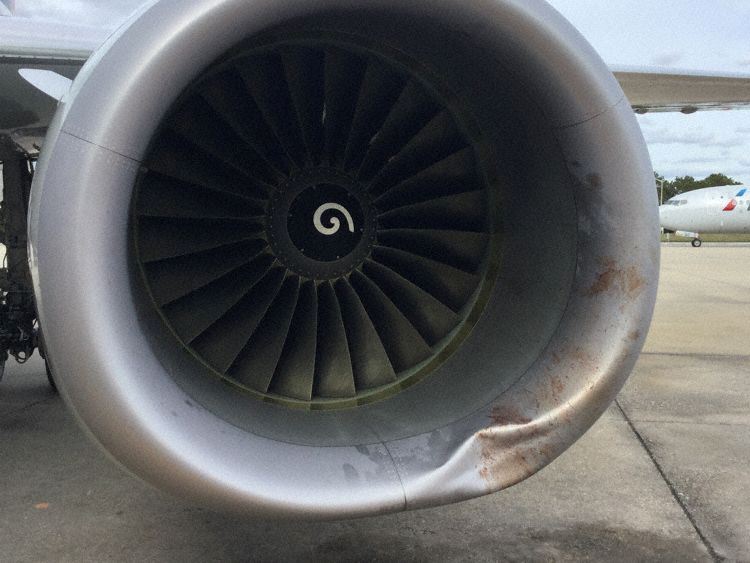
- 15 November – Blenheim (New Zealand)
Air Nelson DH Dash 8, rejected take off after the aircraft passed through a flock of birds and encountered a number of impacts; a visual inspection did not reveal any damage and the aircraft took off again after 30’ - 16 November – Boston (MA)
Jetblue A320, during the take-off run struck a bird on the right side; even in absence of abnormal parameters the crew decided to return for landing for precautionary reasons; a post flight inspection revealed substantial damage to the engine that ingested the bird; - 18 November – Calgary
Canadian North B737, in the initial climb at about 500 ft. the left engine ingested a number of geese; the crew shut the engine down and returned for landing; the runway was closed for over an hour until the debris was cleaned up;
http://globalnews.ca/news/2349503/charter-plane-makes-emergency-landing-at-calgary-airport - 25 November – Sacramento (CA)
United Airlines A320, during the initial climb the right engine ingested a goose and had to be shut down; immediate return 15’ later; - 25 November – Yangoon (Myanmar)
Dragonair A321, during the initial climb struck a bird that caused the windshield to crack; immediate return 30’ later and flight cancelled; - 29 November – Washington (DC)
Virgin Atlantic A330, during the initial climb the left engine ingested a bird and began to vibrate; the crew decided to immediately return for landing; flight cancelled; - 1 December – Turin
Vueling A320, rejected take off after the ingestion of a bird in the right engine, that needed to be replaced;
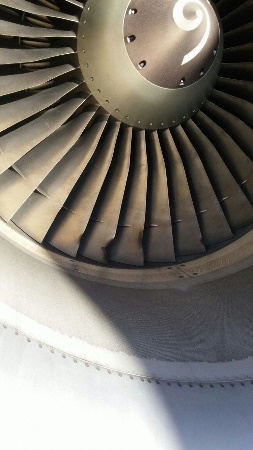
The damage to the fan blades; photo taken from avherald.com - 2 December – Salt Lake City (UT)
Delta Airlines A320, bird strike on approach; minor damage to a wing; - 2 December – Santa Rosa (CA)
Horizon Air, Dash 8, just before the touch down collided with a deer on the runway; minor damage;
http://www.sfgate.com/bayarea/article/Alaska-Airlines-plane-kills-deer-while-landing-in-6677315.php - 3 December - Istanbul (Ataturk)
Turkish Airlines B737, hit a dog on the runway during the landing; no damage but runway closed for removing the carcass; the dog went in the airport through a hole in the fence - 4 December – Jabalpur (India)
Spicejet Dash 8, during the landing a herd of about 40 Indian boars strayed onto the runway; the crew applied the brakes strongly but the aircraft veered to the left with the left main gear and the nose gear collapsed; no injures but substantial damages to the aircraft; three dead boars found on the runway; the Indian CAA started an investigation; the airport stated they did not find any breach in the airport fence;
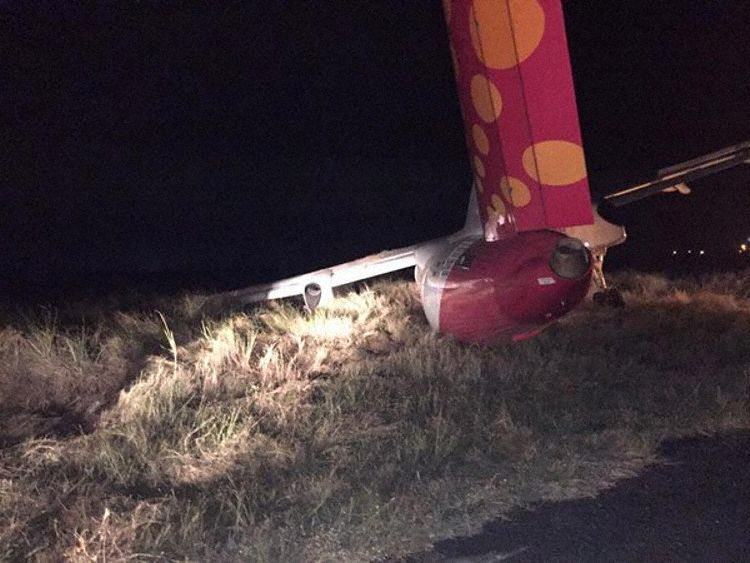
The damaged aircraft – Photo taken from avherald.com - 4 December – Lahore
Pakistan International Airlines B777, bird strike during the approach; next flights cancelled; engine problems reported;
http://en.dailypakistan.com.pk/pakistan/pia-plane-lands-safely-after-bird-strike-in-islamabad
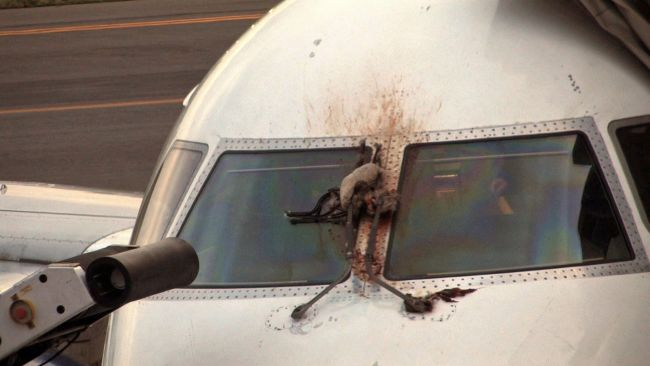
Photo taken from Daily Pakistan - 13 December - Bandar Seri Begawan (Brunei)
Silkair A320, during the approach struck a bird that caused a large hole and a dent on the leading edge of the left wing;
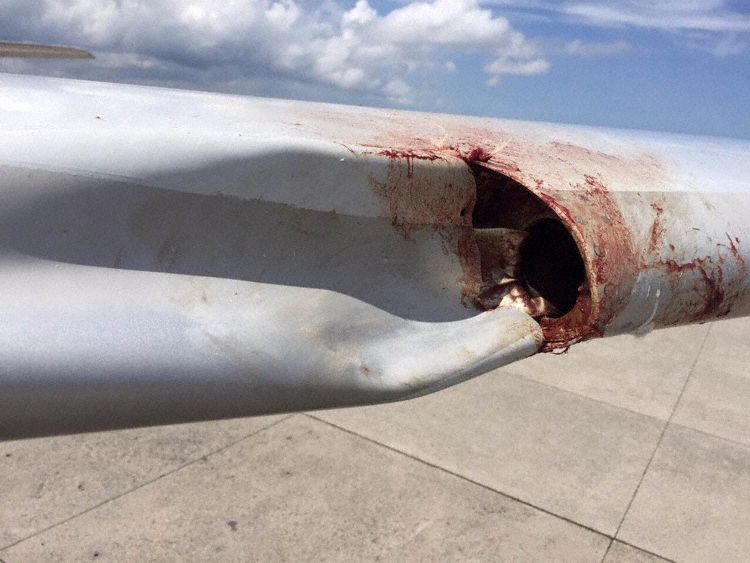
(Photo taken from avherald.com) - 26 December – Sacramento
Southwest B737, bird strike during the initial climb; immediate return; damage to the left elevator; - 31 December – Honolulu (HI)
United Airlines B777, bird strike just prior to touch down;
The U.S. Federal Aviation Agency (FAA) solicited public comments on the need for, and the possible scope of, changes to the bird strike certification requirements for transport category airplanes. The Agency is particularly interested in receiving comments on the resistance that some aircraft parts should have if birds hit them.
Among the reports sent by various experts was that from the Australian “Avisure”, recommending that the certification requirements be in the context of a comprehensive operational mitigation strategy, multipronged, cross disciplinary and based on SMS, rather than as a solution on their own.
Another report was sent by two experts, the American Capt. Paul Eschenfelder and the Italian Valter Battistoni (owner and editor of this website), who highlighted the need to improve the strength of some structures of the aircraft such as the landing gear, the windshield and its supporting structures and the engine mounts based on accidents and incidents in the recent past. However, they mainly called on the FAA to consider not only the resistance to a single impact but also to multiple impacts from flock encounters, an event that is indeed happening more and more frequently. Moreover, the two authors pointed out the need to introduce techniques and procedures for risk reduction where engineering solutions are unavailable or impractical.
The BSCI, a branch of the Italian Civil Aviation Authority (ENAC) released its 2014 Report on the phenomenon of wildlife strikes in Italy.
As usual, we present here our observations and comments.
The most important event of this quarter seems to be that occurred on 17 August in Istanbul (see below) where a B777 of Singapore Airlines flew through a flock of storks that, like other bird species, fly over those areas during their periodic migrations. The White Stork (Ciconia ciconia) weighs about 4 kilos and therefore a multiple impact with several birds of this species can lead to very serious consequences, as in this case. The damage was really substantial: the radome including parts of the weather radar needed to be replaced, the localizer antenna was replaced, engine #2 was replaced with evidence of bird ingestion into the core (no evidence of bird ingestion into the engine #1), both engine nose cowls replaced, a left hand underwing panel replaced and right hand stabilizer leading edge dents repaired. The aircraft was subsequently ferried to Singapore for further maintenance.
The Turkish AIP also warns against migrations with a special Bird Concentration and Movement Chart https://fly.rocketroute.com/plates/adminview/LTBA_BIRD_CONCENTRATIONS_
AND_MOVEMENTS.pdf?cmd=pdf&docid=400000000015288&icao=LTBA but in fact, it leaves things as they are. The best tool to detect the large migrating flocks is the avian radar, but its use is unfortunately still limited: only a few airports in the world have it and furthermore it is generally used for study and research and not for operational-tactical purposes.
Still too many events of bird strike and / or ingestion with decision to continue the flight, followed by a rushed return or a diversion, or even the detection of damage after landing. In the last three months, it happened four times.
Finally, the list of species involved in impacts reports a new entry, the kangaroo, of course in Australia.
-
1 July – Istanbul (Ataturk)
THY B737, rejected take-off at about 100 kts due to a bird strike; - 3 July – Omsk (Russia)
iFly B757, struck a bird during the initial climb and returned for landing 25’ later; - 4 July – Amsterdam
Transavia B737, at take-off a bird was ingested into one of the engines; the crew initially continued the climb but then returned for landing about 30’ later; - 5 July – Paris (De Gaulle)
Air France A320, during the take-off run the left engine ingested a bird; the crew continued take-off, shut the engine down and returned for landing 20’ later; - 16 July – Maracaibo
Venezolana MD83, during the initial climb flew through a flock of birds at least one of which was ingested in the left engine causing bang and streaks of flame; immediate return; - 16 July – Cumana (Venezuela)
Aeropostal MD82, during the initial climb a bird struck the radome prompting the crew to land immediately;
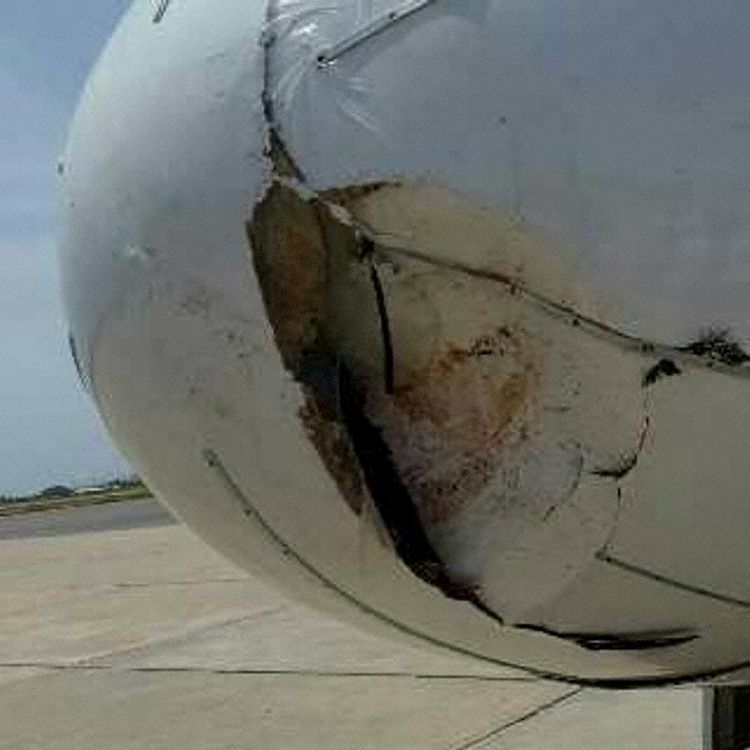
(Photo of Daniel Alexander taken from avherald.com) - 20 July – Kharkov (Ukraine)
Wind Rose A320, rejected take-off t low speed due to a bird impacting an engine intake; minor damage and aircraft immediately released to commercial flight; - 20 July – Munich
Qatar Airways B787, on approach flew through a flock of birds receiving several impacts; return flight cancelled;
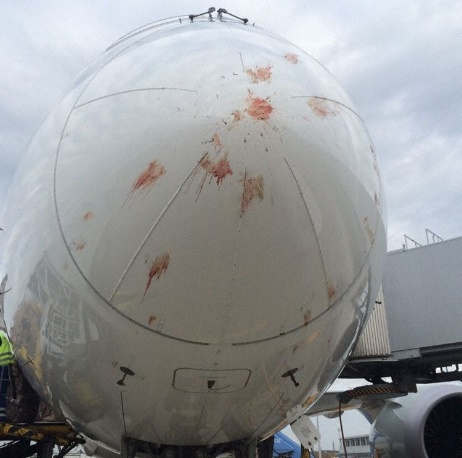
(Photo taken from avherald.com) - 20 July – Curacao
KLM B747, during the approach an engine ingested a bird; the return flight was postponed to the next day due to maintenance; - 21 July – Cairns
Regional Express Saab 340, during the take-off a bird struck the right engine; the crew shut the engine down and returned for landing 35’ later; - 21 July - Between Houston and Los Angeles
United A319, after landing a bird impact on the radome was discovered;
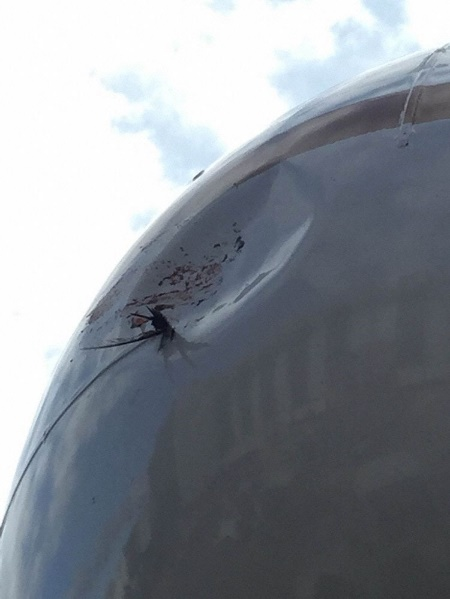
(Photo taken from avherald.com) - 22 July - Amsterdam, KLM B747
rejected take-off at high speed due to multiple impacts with birds (probably crows) that caused vibrations to two engines; - 30 July – Mildura (Australia)
Regional Express Saab 340, rejected a night take-off due to the impact with a kangaroo; the animal struck the right propeller damaging it; - 31 July – Rahim Yar Khan (Pakistan)
PIA A320, during the initial climb suffered a bird strike; in the absence of abnormal parameters the flight was continued but about two hours later the crew decided to divert to another airport; - 1 August – Sylhet (Bangladesh)
Biman A310, during the landing the right engine ingested a bird that caused damage to 4 fan blades; next flight cancelled; - 6 August – Salt Lake City (UT)
Skywest CRJ200, during the approach a bird hit a pitot tube; minor damage; - 10 August – Reggio Calabria
Blu Panorama B737, during the approach a bird struck the landing light on the left wing and took the light out, the return flight was delayed for six hour; - 17 August – Istanbul
Singapore Airlines B777, during the initial climb flew through a flock of storks (Ciconia ciconia) suffering several impacts to the radome and engines; immediate return 40’ later; some birds penetrated the radome and remained embedded; dents also in the leading edge of the right engine inlet;
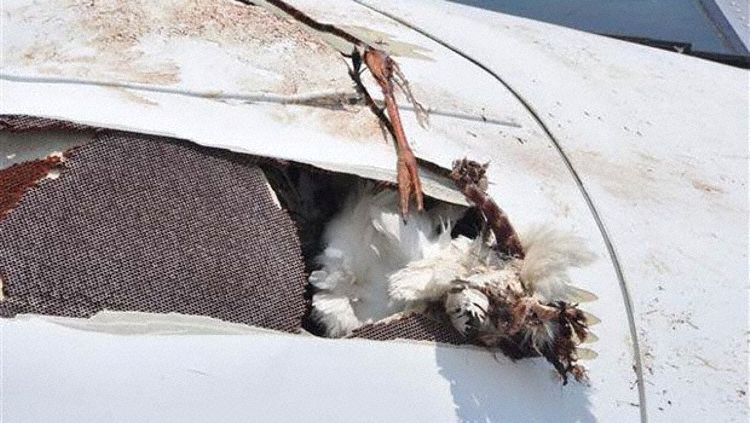
(Photo taken from avherald.com) - 18 August – Montevideo
Iberia A340, during the initial climb flew through a flock of birds; in the absence of abnormal parameters the crew decided to continue the flight; about 50’ later, further to abnormal indication from an engine, the crew decide to divert; flight cancelled; - 20 August – Bhairahawa (Nepal)
Yeti Airlines YS41, rejected takeoff at high speed due to the presence of a flock of birds on the runway; the aircraft veered off the runway and stopped in the grass; no one was injured; the runway of Bhairahawa is 1510 mt. long;
(Photo by Chetan Pant taken from aviation-safety.net) - 20 August – Ahmedabad (India)
Indigo A320, at takeoff the left engine ingested a bird prompting the crew to return about 15’ later; - 22 August – London Luton
Wizzair A320, a large insect later found in a pitot tube caused problems to a speed indicator; immediate return and flight delayed; - 26 August – Richmond (VA)
Envoy Airlines, CRJ 700, during the approach at about 2000 ft. the crew reported an impact with a large black bird; minor damage to the nose cone; - 26 August – Kuwait
Kuwait Airways B777, during the initial climb a bird impacted the windshield; immediate return 30’ later; - 28 August – Tampa (FL)
Spirit Airlines A319, receibed a bird strike at take off and continued to destination; damage to the nose cone; - 30 August - Nakhon Si
Thammarat (Thailand), NOK Air B737, during the initial climb an engine ingested a large bird; the crew decided to divert to another airport where they made an emergency landing about 20’ later; the press reports two earlier emergency landings suffered by aircrafts of Air Asia in the same area;
http://englishnews.thaipbs.or.th/nok-air-flight-makes-emergency-landing-surat-thani-plane-hit-birds - 1 September – Thangool (Australia)
Toll Aviation SA227 Metro III, during the roll out after landing struck a kangaroo; substantial damage to the right engine and propeller; - 5 September – Salt Lake City (UT)
American Airlines A320, during the approach hit a bird crossing 6000 ft.; damage and a dent to the radome; - 8 September – Amsterdam
Delta B747, during the takeoff the engine no. 2 ingested a gull; the crew dumped fuel and returned for landing about 75’later; - 9 September – Islamabad
Emirates B777, on approach hit a bird; damage to the radome and return flight cancelled; - 15 September – Newquay
Flybe Dash 8, rejected take off following an impact with a gull; - 17 September – Manchester
Jet2.com B737, during the approach at about 1200 ft. the left engine ingested a bird that caused repeated compressor stalls, with abnormal noises, smoke and streaks of flame; the crew decided to go around and shut the engine down before landing 20’ later;
http://www.manchestereveningnews.co.uk/news/greater-manchester-news/plane-noise-manchester-jet2-airport-10077466 - 21 September – near Philadelphia
American Airlines A319, climbing and crossing 20.000 ft. One or more birds impacted and cracked a windshield; immediate diversion; - 21 September - Lemnos (Grecia)
Olympic Air Dash 8, rejected takeoff due to an impact with a bird; flight delayed for 90’; - 25 September – Addis Ababa
Emirates A330, immediately after takeoff a bird was ingested into the right engine; the crew shut the engine down and returned to landing about 30’ later; - 25 September – Montreal
Jazz Dash 8, on approach at about 2000 ft. a goose impacted and penetrated the radome, also damaging the hydraulic system no. 2; the crew used the alternative gear extension and landed 15’ later; - 26 September – Guernsey
Aurigny Air Services ERJ-195, rejected take off at high speed following a bird ingestion into the left engine; damage to the fan blades; - 30 September – Hanoi
Vietjet A320, during the approach a bird impacted the radome causing a large dent and also damaging the weather radar;
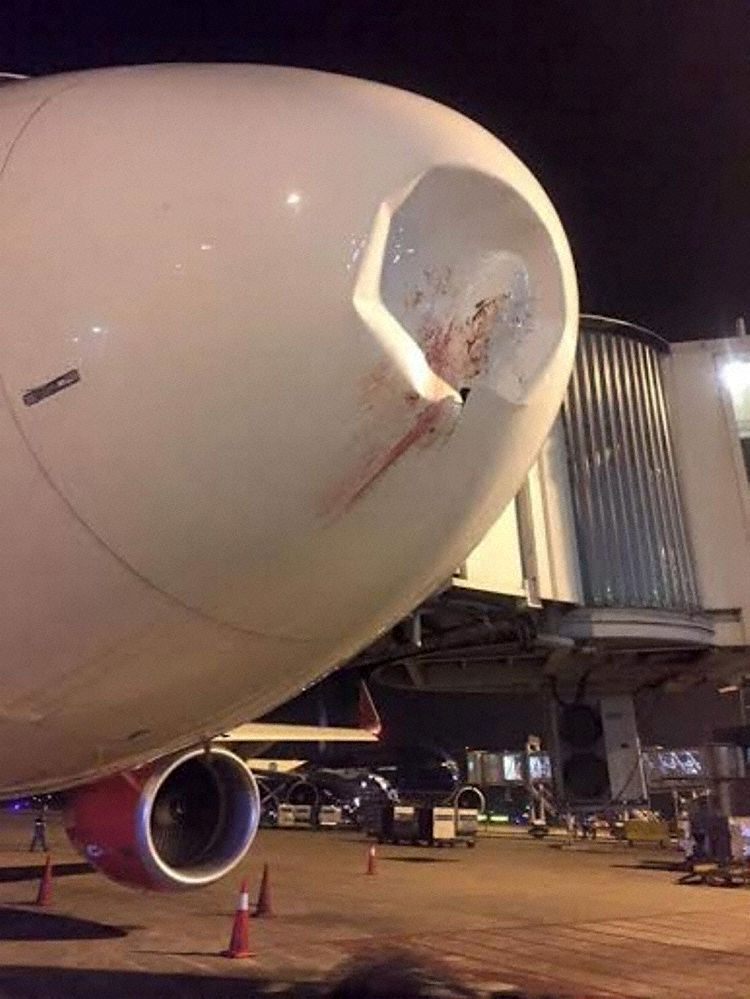
(Photo taken from Avherald.com)
The Court of Appeal of Genoa issued its judgment at the end of the trial for damage compensation following the incident suffered by an Antonov An124 in 1979. During the take off the aircraft flew through a flock of gulls suffering substantial damages and managing to land with an engine shut down and another at reduced power. In the first-degree trial, the liability of several entities including the Ministry of Transport, ENAV (ATC) and the airport operator was recognized.
- The airport complied with all the existing national regulations and adopted all the procedures and prevention measures applicable in that environmental context. This represented a fundamental element for the decision;
- The reconstruction of the dynamics leading to the event, illustrated by the Court expert and recognized as valid by the Court itself, led to the conclusion that it was a fortuitous, exceptional and unpredictable case. So for the first time it was acknowledged that such fortuitous cases can really occur without any responsibility and therefore, the events of this kind must be investigated and analysed on a case-by-case basis. This statement puts an end to the tendency to consider the airport operator’s (and others) liability as something automatic and taken for granted.
The importance of establishing a procedure or an airline policy to help pilots to take a decision in the case of a bird strike not followed by abnormal flight parameters is demonstrated again by four cases occurred in the just ended quarter (19, 27 April, 10 May and 23 June). In the first three, the flight was regularly completed, but at a later stage, it was found out that the airplanes had been damaged or needed further controls, while in the fourth the airline engineers, on the ground, autonomously decided to recall the aircraft to the base while it had just started to cross the Atlantic Ocean.
- 4 April – Manaus
TAM A320, during the initial climb an Urubu (Coragyps atratus) was ingested into one engine; immediate return about 18’ later; the engine needed to be replaced; - 7 April – Ishigaki (Japan)
Japan Transocean Airlines B737, rejected take-off at high speed (118 KIAS) after the right engine ingested a bird and failed; flight cancelled; the Ishigaki airport features a runway 2000 m. long; - 12 April - New York (La Guardia)
JetBlue A320, on final some birds impacted an engine causing damage to the engine cowling; - 13 April - New York (La Guardia)
American Airlines B737, during the initial climb after takeoff the left engine ingested a bird which caused burning smell and smoke in the cabin; emergency landing in another airport of NYC; - 16 April – Alghero (Italy)
Ryanair B737, rejected takeoff at low speed after a gull was ingested into one engine;
http://video.gelocal.it/lanuovasardegna/locale/gabbiano-nel-motore-paura-al-decollo-sul-volo-alghero-roma/41027/41137 - 19 April – San Antonio (TX)
Delta A320, during the initial climb impacted a bird; in absence of abnormal parameters the crew continued the flight to destination; a post-flight inspection revealed damage to the nose cone; - 23 April – Salt Lake City (UT)
Delta A319, at take off a bird struck the left engine; due to engine vibrations the crew decided to declare emergency and to land immediately; - 23 April - Petropavlovsk-Kamchatsky (Russia)
Aeroflot B777, during the final approach an engine ingested a bird; return flight cancelled; - 22 April - Karachi
PIA B777, on final approach flew through a flock of birds receiving several impacts; a post flight inspection revealed damage to a nose landing gear hydraulic line, with one bird remained wedged into the strut, and dents at the right engine inlet and the nose of the aircraft. - 23 April – Sao Paolo (Brazil)
Iberia A330, during the initial climb struck a bird; the crew stopped the climb, dumped fuel and returned for landing about two hours later; - 24 April – Lahore
Oman B737, bird strike during the initial climb; returned after one hour; - 25 April – Jacksonville (FL)
US Airways A319, immediately after becoming airborne the crew reported they had a bird strike with two geese while the Tower reported smoke and some flames from the right hand side, not being sure whether they came from engine or gear; immediate return and flight cancelled; after landing an inspection revealed damage to engine blades, the landing gear and the nose cone with a bird still wedged into the landing gear door;
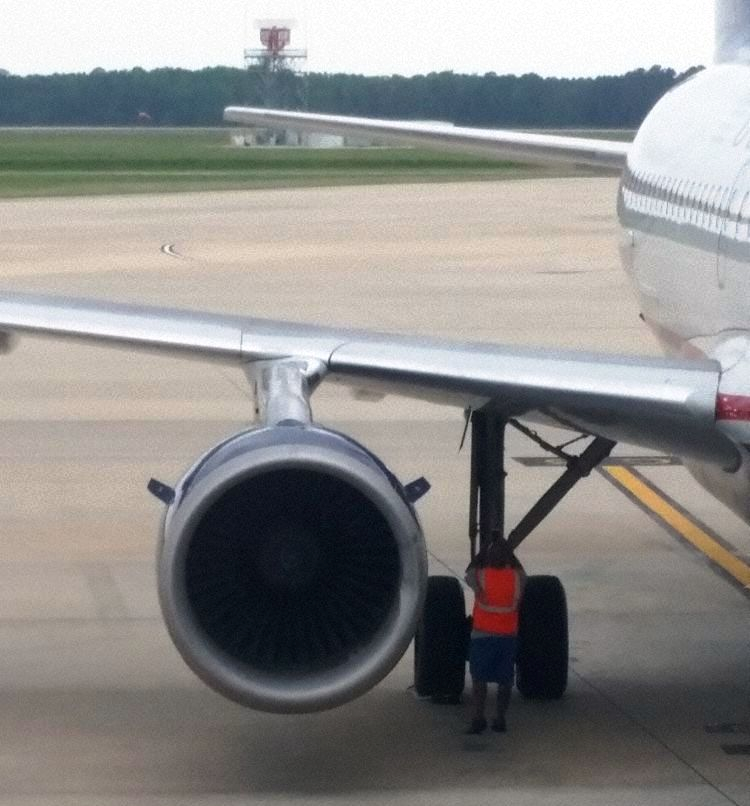
(Photo of Thomas Jerolitsch taken from avherald.com) - 26 April – Stavanger
Norwegian B737, during the initial climb an engine ingested a bird; immediate return about 8’ later; - 26 April -Tel Aviv (Sde-Dov)
Arkia ERJ195, bird strike during the initial climb that prompted the crew to immediately divert to Ben Gurion airport; - 27 April – Lexington (KY)
Envoy ERJ145, at take off a bird struck the landing gear of the aircraft; in absence of abnormal parameters the flight continued to destination; after landing the plane has been grounded for controls; - 28 April - Srinagar (India)
Spicejet B737, bird strike during the approach that caused damage to the nose cone; next flight cancelled;
http://www.newkerala.com/news/2015/fullnews-50725.html - 3 May – Menorca (Spain)
Vueling A320, rejected take off at high speed after a bird was ingested in the left engine causing a loud bang and a flash; flight cancelled; - 5 May – Genoa
Vueling A320, during take off the left engine ingested one or more gulls after reaching V1; the crew declared emergency and landed with a single engine approach; - 5 May – Nevsehir (Turchia)
THY B737, on final approach flew through a flock of birds suffering many impacts;
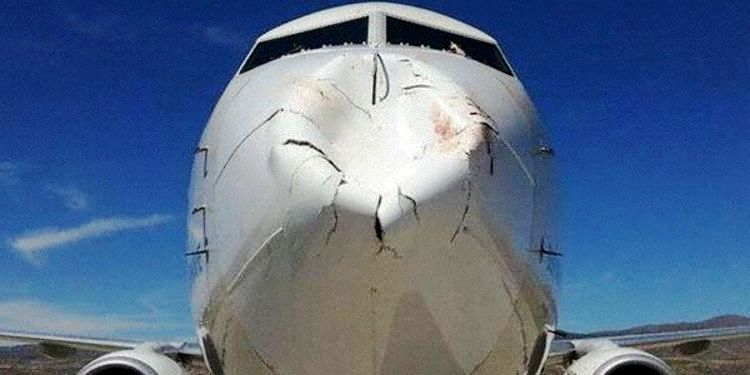
(Photo: Turkish plane, taken from avherald.com) - 10 May – New York (La Guardia)
Jetblue A320, bird strike at take off; in the absence of normal indications the crew decided to continue the flight to destination; a post-flight inspection revealed damage to the nose cone; - 12 May – Istanbul
THY A340, flew through a flock of birds at take-off suffering several impacts; immediate return 25’ later; - 12 May – Santiago de Chile
LAN B787, on approach flew through a flock of birds receiving a number of bird strikes into both engines, pitot tubes, nose cone and landing gear;
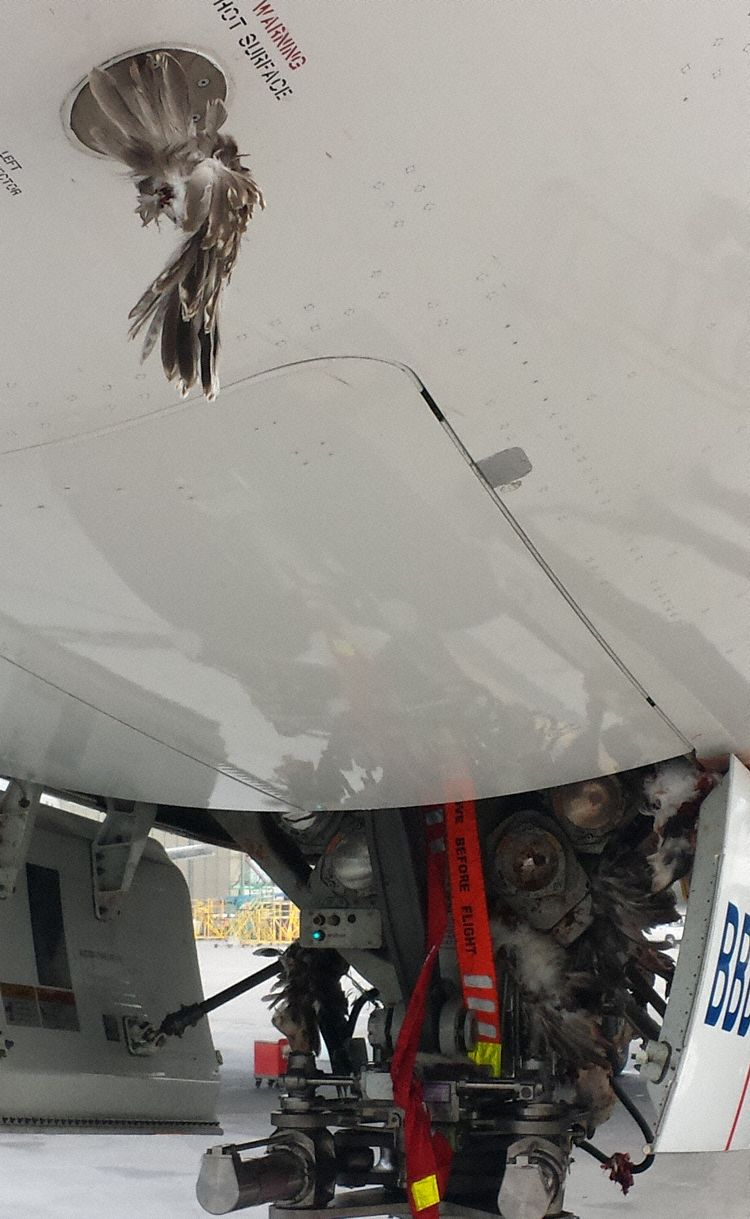
(Photo taken from avherald.com) - 13 May – Plovdiv (Bulgaria)
Ryanair B737, on approach suffered an impact with an eagle near an engine that caused some dents in a wing; - 14 May – Los Angeles (CA)
American Airlines MD83, after take-off declared emergency and returned for an overweight landing; - 15 May – Atlanta (GA)
Delta MD88, bird strike on approach; damage to the nose cone; - 15 May – Keflavik (Islanda)
Air Berlin A320, at take off the left engine ingested a bird; the crew decided to immediately return and landed 30’ later; - 28 May – Athens
Fly Niki A230, during the initial climb the right engine ingested a bird forcing the crew to shut down the engine and return for landing; due to the presence of thunderstorms on the airfield the approach was problematic and the landing was completed only after the thunderstorms had moved across the airfield; - 4 June – Anapa (Russia)
UTAir B737, rejected take off further to a bird ingestion into one engine; flight cancelled; - 5 June – Rome
Alitalia A319, impact with birds during the initial climb; immediate return and flight cancelled; - 5 June –Green Bay (WI)
Delta A319, impact with birds during the initial climb that caused engine vibrations and the need to return immediately; - 5 June – Southampton
FlyBe D.H. Dash 8, after take-off the crew reported unreliable airspeed indications and decided to return for landing; the maintenance found a bee stuck in one pitot tube; - 7 June – Berlin
Air Berlin B737, during the initial climb flew through a flock of pigeons receiving several strikes; a number of birds was ingested into the right engine; immediate return; the runway was closed for about one hour in order to remove the carcasses of birds; - 8 June – Verona
Easyjet A320, rejected take off due to a bird strike;
http://corrieredelveneto.corriere.it/veneto/notizie/cronaca/2015/9-giugno-2015/volo-easyjet-catullo-londra-fermato-dall-impatto-un-uccello-2301494163878.shtml?refresh_ce-cp - 9 June – Naples
Alitalia A320, during the initial climb a bird hit the aircraft; immediate return;
http://www.ilmattino.it/articolo.php?id=1401586&sez=NAPOLI&ssez=CRONACA - 13 June – Catania
Volotea A320, after take-off flew through a flock of birds; the crew decide to divert to a close airport to assess the damage; the aircraft departed again to destination 40’ later;
http://www.lastampa.it/2015/06/14/italia/cronache/ancora-un-impatto-con-gli-uccelli-terzo-atterraggio-in-pochi-giorni-BfHSdfPGg0B7elxeIyoBbO/pagina.html - 17 June – New York (La Guardia)
Transtates ERJ 145, during the final approach a bird struck the landing gear causing minor damage; - 17 June – Biratnagar (Nepal)
Yeti Airlines Jetstream 41, during rotation a bird struck one engine; immediate return; - 20 June – Cologne
Lufthansa A320, rejected take off after a bird ingestion into one engine; - 23 June – Simferopol
Ikar Airlines B767, during the initial climb the right engine ingested a bird; the crew shut the engine down, burn off fuel and returned about 45’ later; - 23 June – London (Heathrow)
British Airways B777, on take-off suffered a bird strike to the right engine but continued to cross the Atlantic ocean; however the engineers on the ground wanted to check the engine out and the aircraft dumped fuel and returned to London; the flight was cancelled; unconfirmed sources reported that the engine received substantial damages and had to be replaced; - 25 June – Jaipur (India)
Air Arabia A320, during the initial climb a bird struck an engine prompting the crew to return for an immediate landing; following repairs to the engine inlet the flight was operated 24 hours later; - 26 June – Hamburg
Easyjet A319, rejected take off at high speed due to a bird ingestion into one engine that caused its failure; - 30 June – Bastia (Corsica)
Air Corsica A320, bird strike during the initial climb; immediate return;
On June 16 2015, the Italian Civil Aviation Authority has officially presented its report and social balance for the year 2014. One page (127) of it has been dedicated to the phenomenon of the wildlife strike. Although these data are still provisional, waiting the more specific report that will be issued by the Bird Strike Committee, the overall number of impacts appears to remain a little over a thousand, however, slightly lower than in 2013. The impact decrease would be the first detected since records began in 2002. More important, however, is the number reduction of significant impacts (multiple, with damage and ingestions) so that ENAC looks to the future with optimism.
On 21 April 2015, the Italian Agency for Flight Safety (ANSV) released its annual report on its activities and the state of safety of civil aviation in Italy during 2014. In the past year, the Agency received 51 reports of events occurred in Italy for none of which they considered appropriate to open a safety investigation, not recurring the necessary conditions, in view of about a thousand events reported to ENAC through the proper channels.
http://www.ansv.it/cgi-bin/ita/Rapporto%20ANSV%20anno%202014_.pdf
The New Zealand Transport Accident Investigation Commission (TAIC) released an investigation report into an incident in which an Air New Zealand Airbus A320 suffered an engine failure after having been cleared to fly, according to procedures, following a bird strike incident at Wellington, New Zealand.
On 20 June 2012 an Air New Zealand Airbus A320 was landing at Wellington International Airport when it suffered a bird strike to its right engine. The bird strike did not affect the landing. The bird was later identified as a black-backed gull.
Maintenance engineers inspected the engine in accordance with the Airbus aircraft maintenance manual and released it back into revenue service later the same day for a flight to Auckland with 172 persons on board, including five crew members.
The Airbus aircraft maintenance manual required parts of the engine to be inspected using a borescope. However, as the bird strike had involved only one engine and no damage had been observed, the aeroplane was allowed to continue in service for up to 10 hours’ flying or one more sector (one more take-off and landing), whichever came first. The engine was then required to undergo the borescope inspection. The aeroplane was released to fly to Auckland under this “continued operating allowance”.
On approach to land at Auckland International Airport the same engine suffered a failure. The captain reduced the engine thrust to idle and continued with the landing. Although damaged internally, the engine continued to run and was used during the landing.
An inspection of the failed engine revealed damage to components caused by the bird being ingested down the core of the engine. This damage had led to cracking in a compressor blade in the third-stage compressor. The crack in this blade grew further under the stress of continued engine operation in a damaged state. It finally fractured completely and caused significant damage to other components as it passed through other compressor stages in the jet engine.
This was the first reported occurrence worldwide where a V2500 engine had failed while operating under the continued operating allowance having had a bird strike down the engine core. TAIC reviewed the operating parameters and airworthiness requirements that underpinned the authority to continue operating the engine. The Commission found that the resultant risk to aviation safety was reasonable, so made no recommendations.
The aeroplane systems would normally have generated automatic reports to the operator’s maintenance operations control during the flight, which could have alerted it that the damage to the engine from the bird strike was worse than initially thought. However, these did not reach the control centre as intended. The reasons that gave rise to this have now been rectified.
The Commission also reviewed the Wellington International Airport’s measures to control bird life around the aerodrome, and found that these met industry best practice.
The Commission has made no new recommendations arising from this inquiry.
However, it notes the following key lessons:– Although the safety of the aeroplane and the persons on board was not unduly compromised by releasing the aeroplane to service knowing that a bird had been ingested into the core of one engine, operators will need to balance the cost of having inspection services available at key aerodromes into which they fly with the cost of an engine failure of this scale.
- Even if the minimum mandatory checks are made to an engine that has suffered a bird strike down the core, if the aeroplane is released to service before the required full inspection has been undertaken, the pilots and ground engineering services should maintain increased vigilance of engine performance until the appropriate full maintenance checks can be completed.
- 7 January – Portland (OR)
Air Transport International Boeing 757, cargo flight; during the initial climb the crew reported abnormal vibrations, and the consequent loss of an engine; immediate return. A runway inspection revealed the remains of five Pintail ducks (Anas acuta). This species can weigh up to more than one kilo.
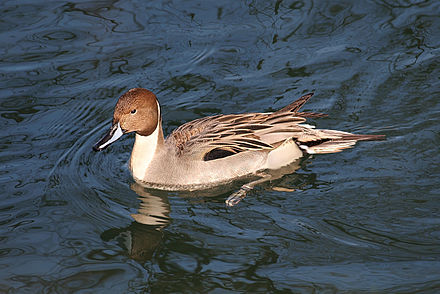
(Photo taken from Wikipedia)
- 7 January – Salt Lake City (UT)
Fedex DC10 immediately after take-off the crew reported to the TWR a bird strike and vibrations. In the absence of abnormal engine indications they decided to continue the flight to destination but about 30’ later they returned to the departure airport.
- 8 January – near Guangzhou (Cina)
Westair Airbus A320, during the climb after take off abnormal sounds and a burning smell were noticed in the cabin prompting the crew to divert to the nearest suitable airport suspecting a bird ingestion into one engine.
- 8 January – Kisangani (R.D. Congo)
Compagnie Africaine Aviation A320, the left engine ingested a bird at take off; minor damage;
- 9 January – Moruya (Australia)
REX Regional Express SAAB 340, on approach suffered a multiple impact from a number of Galahs (Eolophus roseicapilla). After the landing the crew performed an inspection of the aircraft to assess possible damage and, finding no anomaly, continued for the next sector.During the approach the crew noticed abnormal vibrations. Another more thorough inspection performed after the final landing revealed that a section of a propeller was missing. A Galah weighs about 300 gr.
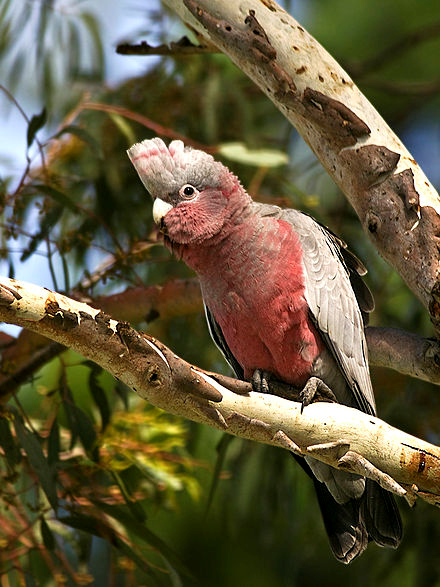
(Photo taken from Wikipedia)
- 9 January – Manila
Cebu Pacific Airbus A320, bird strike during the initial climb prompting the crew to immediately return after 15’ of flight.
- 9 January – Sacramento (CA)
United Airlines Boeing 737; during the initial climb the right engine ingested a number of birds that caused repeated bangs and streaks of flame; immediate return with one only engine after about 25 minutes.
- 24 January – Amsterdam
KLM B737, during the initial climb the right engine ingested a bird; the crew reduced the thrust to that engine and landed 20’ later; TWR advised about gull presence;
- 25 January – Mazatlan (Mexico)
Aeromexico Connect ERJ190, after take-off could not fully retract the landing gear due to an impact with a bird revealed after the landing; flight cancelled;
- 27 January – Istanbul
THY A320, bird strike during the initial climb; the crew decided to return;
- 30 January – Naypydaw (Myanmar)
Golden Myanmar A320, during the approach a bird struck the nose cone causing a dent; minor damage;
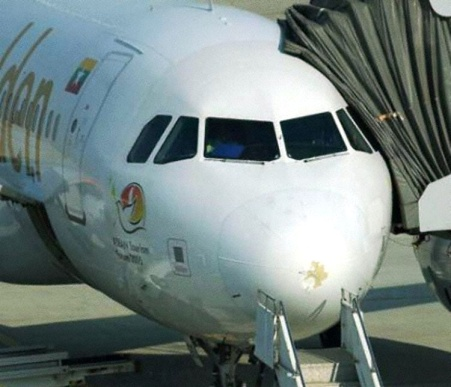
(Photo taken from avherald.com)
- 30 January – Sao Luiz (Brasile)
Azul Linhas Aereas ERJ195, at take off an Urubu (Coragyps atratus) struck the right engine and then was ingested into it causing the engine to fail; immediate return;
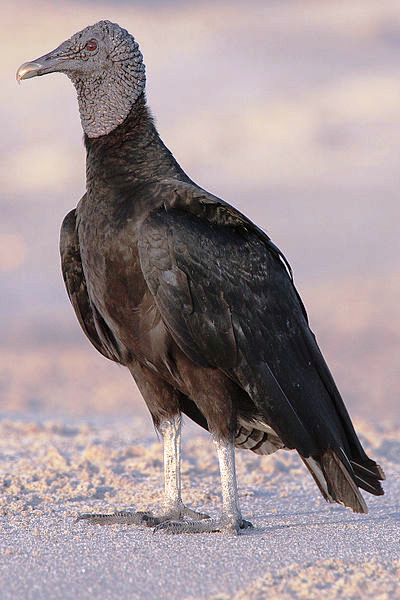
(Photo taken from Wikipedia)
- 6 February – Turbat (Pakistan)
PIA ATR42, during the approach struck a bird; next leg cancelled;
- 10 February - Casablanca
Etihad A330, bird ingestion into one engine at take off; and immediate return; minor damage but flight cancelled;
- 15 February – Gdansk (Poland)
Ryanair B737, rejected take off at about 70 knots following a bird ingestion into one engine;
- 16 February – Rio Hato (Panama)
Sunwing Airlines B737, suffered a bird strike during a night take off; after a holding pattern a safe landing was performed about one hour later; passengers were flown back with other flights and the aircraft was ferried back;
- 19 February, Lahore
PIA B777, on approach a bird struck the right engine; next flight cancelled due to engine maintenance;
- 25 February – Reggio Calabria (Italy)
Alitalia A319, rejected take off further to multiple impacts with a flock of gulls;
http://quicosenza.it/calabria/18388-paura-sul-volo-reggio-calabria-milano-linate-aereo-alitalia-impatta-contro-uno-stormo-di-uccelli#.VO2fBE1MuUk
- 26 February – Barcelona
Ryanair B737, during the initial climb a bird was ingested into an engine that needed to be shut down; the crew called an emergency and landed 20’ later;
- 26 February – St. Croix (Virgin Islands)
Jetblue ERJ190, during the initial climb, just over a landfill close to the airport, a bird was ingested into the right engine; immediate return 10’ later;
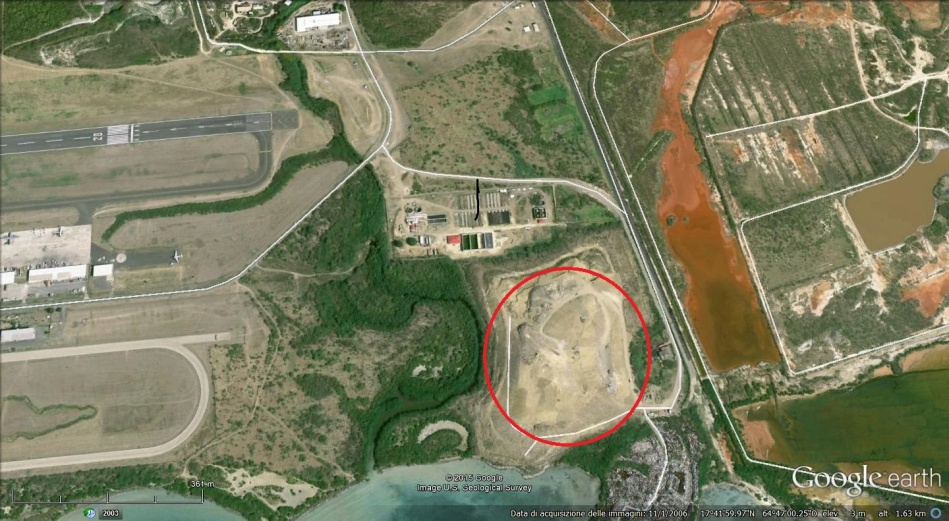
(The landfill of Anguilla, close to the airport)
- 3 March, Paraburdoo (Australia)
Network Aviation F100, during the initial climb a large bird, probably an eagle or an otard impacted and penetrated the nose cone becoming embedded into the fuselage and causing substantial damage to nose and fuselage;
- 6 March - Dallas (TX)
American Airlines B737, at departure flew through a flock of birds suffering multiple impacts and damage to radome and one engine; immediate return;
- 6 March – Santander
Air Nostrum CRJ 900, on final approach the right engine ingested a bird; substantial damage;
- 8 March – Washington (DC)
Frontier Airlines A320, on approach struck a bird receiving damage to the nose cone;
- 17 March – Beirut
Lufthansa A321, during the initial climb flew through a flock of birds and ingested a number of them into the left engine; the crew shut the engine down and landed immediately about 16’ later; substantial damage to the engine;
http://www.ilmessaggero.it/SOCIETA/NOLIMITS/aereo_stormo_uccelli_passeggero
_riprende_fiamme_motore/notizie/1251737.shtml
- 17 Marzo – New York (JFK)
American Airlines B757, climbing after takeoff through 1900 ft. the crew reported they flew through a flock of geese and received a number of impacts but did not immediately require assistance; crossing 7.000 ft. the crew advised they might need to return; about 3 minutes after declared emergency advising they were returning for an overweight landing; in the meanwhile other aircrafts reported flocks of geese around the airfield at different altitudes;
http://newyork.cbslocal.com/2015/03/17/plane-forced-to-return-to-jfk-after-bird-strike
- 22 March – Kathmandu
Thai Airways B777, during the approach, crossing 8500 ft, the right engine ingested a bird; minor damage;
- 25 March – Lamezia Terme
Ryanair B737, after take off flew through a flock of birds; immediate return;
http://tv.ilfattoquotidiano.it/2015/03/25/aereo-ryanair-diretto-a-roma-impatta-stormo-di-uccelli-e-rientra-a-lamezia/353416
- 30 Marzo – Christchurch
Air New Zealand B737, during the initial climb a probable bird ingestion forced the crew to shut down one engine; immediate return;
- 31 March – Mumbai
Jet Airways B737, suffered a bird strike while landing; five aircraft had to be diverted to another airport and four had to make a go-around, aborting approach, due to the closure of the runway for inspection and removal of bird carcass;
Several are the cases worthy of attention and comment that have occurred in the first quarter of 2015.
In our view, the most significant event, and in some respects the most instructive, is that of February 26 in St. Croix, not so much for the fact itself (unfortunately the bird ingestion has become an almost normal event), but rather for the particular location of the landfill, very close to the runway and in clear contradiction with the ICAO regulations that expressly requires a minimum distance of 13 km. The FAA has always pressed for the landfill closure, but it seems that now is willing to accept an extension of its operation until 2020.
The presence of the landfill is not only an attractive factor for birds but also a problem of visibility because of the smoke that it produces (APCH TO RY 28 SMTMS OBSCD BY SMOKE FM LCTD LANDFILL AND OF ARPT).
Another major event occurred on January 9 in Australia; an aircraft inspection performed after a multiple bird strike did not allow to detect anything abnormal; however in the next leg abnormal vibrations were perceived that then turned out to be depending on a missing section of a propeller. We hope that the section dropped after, and that the crew did not perform a hasty inspection.
So many times we commented on the decisions of the crew that after a bird strike, in the absence of abnormal parameters, continue the flight but then rush back or divert to another airport due to the consequences of the impact. This time it was a Fedex DC10 on January 7. Probably the crew must have considered they had three engines and a number of airports available along the route.
Finally we would like to highlight two events occurred in one month (and we hope this is just a coincidence) in the two airports of Calabria, in southern Italy (February 25 and March 25). In both cases the aircraft impacted with a flock of birds just on the runway. In both airports (Reggio and Lamezia) until 2013 (latest available data from ENAC) a wildlife management plan (WMP) did not exist yet. We are afraid that this is not a coincidence.